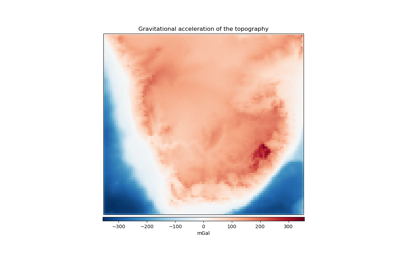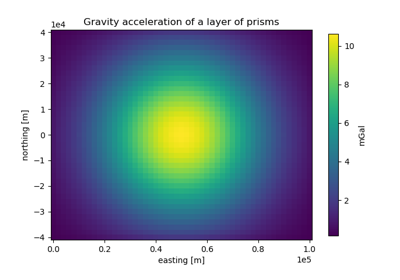harmonica.prism_layer¶
-
harmonica.prism_layer(coordinates, surface, reference, properties=None)[source]¶ Create a layer of prisms of equal size
Build a regular grid of prisms of equal size on the horizontal directions with variable top and bottom boundaries and properties like density, magnetization, etc. The function returns a
xarray.Datasetcontainingeasting,northing,topandbottomcoordinates, and all physical properties asdata_vars. Theeastingandnorthingcoordinates correspond to the location of the center of each prism.The
prism_layerdataset accessor can be used to access special methods and attributes for the layer of prisms, like the horizontal dimensions of the prisms, getting the boundaries of each prisms, etc. SeeDatasetAccessorPrismLayerfor the definition of these methods and attributes.- Parameters
coordinates (tuple) – List containing the coordinates of the centers of the prisms in the following order:
easting,northing. The arrays must be 1d arrays containing the coordiantes of the centers per axis, or could be 2d arrays as the ones returned bynumpy.meshgrid. All coordinates should be in meters and should define a regular grid.surface (2d-array) – Array used to create the uppermost boundary of the prisms layer. All heights should be in meters. On every point where
surfaceis belowreference, thesurfacevalue will be used to set thebottomboundary of that prism, while thereferencevalue will be used to set thetopboundary of the prism.reference (float or 2d-array) – Reference surface used to create the lowermost boundary of the prisms layer. It can be either a plane or an irregular surface passed as 2d array. Height(s) must be in meters.
properties (dict or None) – Dictionary containing the physical properties of the prisms. The keys must be strings that will be used to name the corresponding
data_varinside thexarray.Dataset, while the values must be 2d-arrays. All physical properties must be passed in SI units. If None, nodata_varwill be added to thexarray.Dataset. Default is None.
- Returns
dataset (
xarray.Dataset) – Dataset containing the coordinates of the center of each prism, the height of its top and bottom boundaries and its corresponding physical properties.
See also
Examples
>>> # Create a synthetic relief >>> import numpy as np >>> easting = np.linspace(0, 10, 5) >>> northing = np.linspace(2, 8, 4) >>> surface = np.arange(20, dtype=float).reshape((4, 5)) >>> density = 2670.0 * np.ones_like(surface) >>> # Define a layer of prisms >>> prisms = prism_layer( ... (easting, northing), ... surface, ... reference=0, ... properties={"density": density}, ... ) >>> print(prisms) <xarray.Dataset> Dimensions: (northing: 4, easting: 5) Coordinates: * easting (easting) float64 0.0 2.5 5.0 7.5 10.0 * northing (northing) float64 2.0 4.0 6.0 8.0 top (northing, easting) float64 0.0 1.0 2.0 3.0 ... 17.0 18.0 19.0 bottom (northing, easting) float64 0.0 0.0 0.0 0.0 ... 0.0 0.0 0.0 0.0 Data variables: density (northing, easting) float64 2.67e+03 2.67e+03 ... 2.67e+03 :ivar ~prism_layer.coords_units: meters :ivar ~prism_layer.properties_units: SI
>>> # Get the boundaries of the layer (will exceed the region) >>> print(prisms.prism_layer.boundaries) (-1.25, 11.25, 1.0, 9.0) >>> # Get the boundaries of one of the prisms >>> print(prisms.prism_layer.get_prism((0, 2))) (3.75, 6.25, 1.0, 3.0, 0.0, 2.0)


